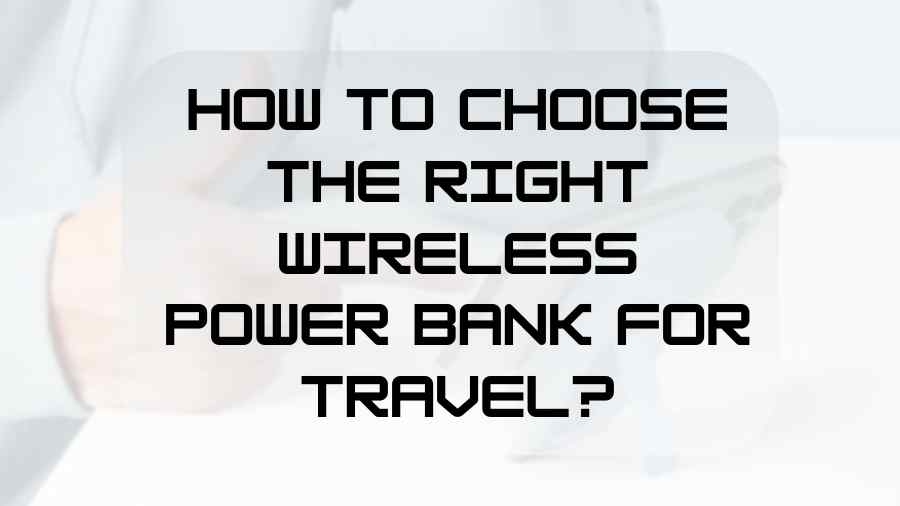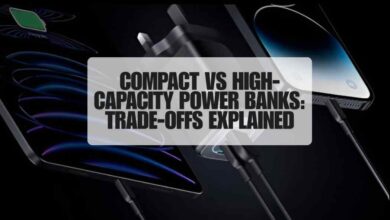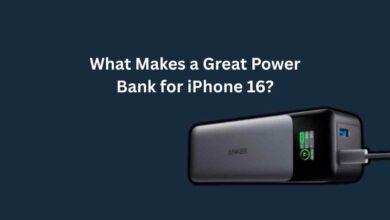How to Choose the Right Wireless Power Bank for Travel?

Choosing the right wireless power bank for travel can make your journey seamless and stress-free. Whether you’re a seasoned traveler or planning your first excursion, ensuring your devices stay charged is essential. Understanding your power needs, while balancing portability and compliance with airline regulations, is crucial. This guide explores the key considerations for picking a power bank that aligns with your travel style. We’ll discuss the importance of capacity, portability, and safety standards, as well as the features to look for in a wireless power bank. By the end, you’ll have clarity on selecting a power bank that’s not only convenient but also safe and efficient for your travel needs.

Key Travel Considerations Before You Buy
Identifying your travel power needs is the first step. Additionally, consider how much weight you’re willing to add to your luggage. A well-considered balance between size and capacity will prevent you from carrying an unnecessary load. Don’t forget to review airline regulations to ensure your chosen power bank meets airport safety requirements.
Capacity – How Much Do You Actually Need?
The capacity of a power bank, measured in milliampere-hours (mAh), determines how many times it can charge your device. For a smartphone, a 5,000 mAh power bank can offer approximately one full charge, while a 10,000 mAh unit doubles that. Consider your devices—do you need to charge a smartphone, tablet, or laptop? For average travelers who mostly use their phones, a 10,000 mAh power bank is often sufficient. However, if you use multiple high-consumption devices, you might require something closer to 20,000 mAh. Keep in mind that higher capacities come with increased weight and size, potentially affecting your portability.
Weight and Portability – Packing Smart
Traveling light is an art, and every ounce counts. Light power banks usually range between 6 to 12 ounces, with smaller capacities. For those on the move frequently, a lightweight model around 10,000 mAh offers an ideal balance. Check if your choice fits compactly into your hand luggage. Slim designs often slide easily into bags or even pockets, which is ideal for hassle-free travel. Despite the lure of multi-functional models, ensure they are not too cumbersome or awkward to carry. A lightweight, portable power bank enhances the convenience of recharging on the go.
Airport, Airline and Safety Regulations You Must Know
Before packing a power bank, familiarize yourself with airline and airport regulations. Most allow power banks under 100 watt-hour (Wh) in carry-on luggage but not in checked bags. This translates roughly to a 27,000 mAh power bank, more than enough for travel needs. Check specific airline restrictions, as exceeding this limit may cause inconveniences. Look for certifications such as CE, FCC, and RoHS ensuring compliance with international safety standards. Knowing your power bank aligns with regulations is vital to avoiding delays during security checks.
Wireless Power Bank Features That Matter
Besides satisfying basic needs, a power bank should offer essential features that enhance your experience. Wireless charging, multiple ports, fast output, and sturdy build quality all play significant roles.
Wireless Charging Specs
Not all power banks are created equal, especially when it comes to wireless charging performance. Look for models with Qi certification, which guarantees safe and reliable compatibility with most modern smartphones, including the latest iPhone and Android devices. A 10W or 15W output ensures faster charging speeds, perfect for quick boosts during travel or busy days. Some advanced options even support simultaneous wired and wireless charging, allowing you to power multiple devices at once. For the best results, choose a versatile power bank that matches your device’s voltage, wattage, and charging technology for optimal efficiency and convenience.
Ports, Outputs, and Charging Speed
Versatile charging options greatly enhance a power bank’s overall utility and convenience. High-quality models often feature both USB-C and traditional USB-A ports, accommodating various devices and accessories simultaneously. Support for fast-charging protocols like Quick Charge and Power Delivery ensures rapid energy transfer, cutting down charging time dramatically. A power bank with at least 18W output can efficiently power smartphones, tablets, and even smaller laptops. For travelers or professionals carrying multiple gadgets, multiple output ports—including high-speed data input/output—streamline connectivity. Equally important, choose a model that recharges quickly, minimizing downtime between uses for continuous reliability.
Safety, Certifications, and Build Quality
Safety is paramount when dealing with lithium batteries, as improper handling can pose serious risks. Always choose power banks certified by CE, FCC, and RoHS, which guarantee compliance with international safety standards. Look for models featuring built-in protections against overcharging, overheating, and short-circuits, ensuring your devices and battery remain secure during use. A durable, shockproof casing—preferably made of metal or high-quality plastic—adds extra defense against drops, impacts, and travel-related wear. Reliable power bank manufacturers emphasize user safety alongside performance, proving that durability and protection are essential, not optional, qualities in a trusted power bank.

Matching the Right Power Bank to Your Travel Style
Understanding the nature of your trips helps in choosing a power bank that suits your lifestyle. Align your choice with the length and nature of your journeys for optimal benefit.
Short Trips, Day-Use, and Minimal Gear
For shorter trips or everyday use, a compact, lightweight power bank with a capacity between 5,000 mAh and 10,000 mAh is the perfect companion. These models balance portability and performance, offering enough power for two to three full smartphone charges without adding bulk. Their sleek, pocket-friendly designs fit easily into handbags or travel pouches, making them convenient for commutes, meetings, or casual outings. Choosing a power bank that supports fast-charging protocols ensures your devices recharge quickly, keeping you connected throughout the day. Reliable, stylish, and practical—these compact options deliver dependable power wherever you go.
Long-Haul Flights, Multi-Device Travel, and Heavy Use
Long trips, especially those involving long-haul flights or destinations with limited charging access, demand reliable and powerful charging solutions. A 20,000 mAh power bank or higher capacity is ideal for keeping smartphones, tablets, cameras, and other devices powered for days. Look for models equipped with dual-output or USB-C ports to charge multiple gadgets simultaneously and efficiently. Sturdiness, compact design, and fast recharging capabilities are crucial for travelers who rely on their tech. For globetrotters balancing work, entertainment, and connectivity, a high-capacity power bank becomes an indispensable travel essential.
Conclusion
Selecting the right wireless power bank for travel involves balancing capacity, portability, and safety with your personal needs. By considering your travel habits and the devices you carry, you can better match your power requirements to the available options. Look for quality features such as fast charging, multiple ports, and sturdy construction to enhance your travel experience. Remember that keeping in line with airport and airline regulations is essential. With the right choice, your gadgets will remain charged, ensuring smooth, uninterrupted journeys.



